![]()
![]()
![]()
Use LEFT and RIGHT arrow keys to navigate between flashcards;
Use UP and DOWN arrow keys to flip the card;
H to show hint;
A reads text to speech;
104 Cards in this Set
- Front
- Back
|
The five factors need to be aware of when performing audiometric
testing are: |
Test equipment, environment, patient, clinician/audiologist, and the test procedure
|
|
|
what is test equipment and big concern regarding it
|
our audiometer and other ancillary equipment. One concern is calibration of equipment.
|
|
|
most of the testing audiologists perform will be done with a
|
diagnostic
audiometer |
|
|
Audiometer output limits for bone conduction and why?
|
note the audiometer produces lower intensity limits for bone conduction than it does for air conduction. The reason for this mostly is that more power is needed to drive a bone conduction oscillator than the diaphragm in the air conduction outputs. When bone conduction is driven at high intensity levels, harmonic distortion can result/tactile sensation can occur.
|
|
|
Lower intensity limits of audiometer
|
0 db HL to -10 db HL
|
|
|
Higher intensity limits of audiometer for air conduction
|
Air: 125 hz=75 db;
250 hz & 8000 Hz both = 90 db; 500, 1000, 2000, & 4000 Hz all =110 db |
|
|
Higher intensity limits of audiometer for bone conduction
|
250 hz=40 db
500, 1000, 2000, 4000 all=65 db |
|
|
greatest concern about testing environment
|
greatest concern is background noise
|
|
|
3 ways to attenuate ambient noise:
|
i. earphone enclosures
ii. receiver inserts iii. sound treated chambers |
|
|
Advantages to insert receivers
|
a. Cross hearing masking
b. Exclusion of delivery stimulus |
|
|
Types of controlled environments for testing
|
quiet environment – controlled – sound booth or sound treated room. Both 1 room and 2 room suites. Environment of a sound treated booth has been designed, manufactured and available for audiometric testing.
|
|
|
Audiometer delivers tones from ___ hz to ___ hz
|
125-8000 Hz however the upper limit intensity will vary by frequency and by audiometer
|
|
|
Harmonic distortion can occur with
|
bone conduction at high intensity
|
|
|
Background noise can affect results by
|
elevating the patient's thresholds
|
|
|
Patients vary in:
|
age, intelligence, education, motivation and willingness to cooperate
|
|
|
Patient response is required. Types of response:
|
raise hand/finger, press signal button (prof preferred), verbal response
|
|
|
Important aspects regarding the clinician doing the testing
|
o Needs to be properly trained
o Understand the patient, equipment, test procedure and other factors that can impact results o Carries out test procedure and protocol properly o Obtain complete case history and visual inspection of pinna and ear canal and otoscopy before test performed to rule out active pathological conditions o Give proper instruction to patient (tests can vary by 10dB due to instructions) o Monitor patient’s alertness and physical condition at all times and proper test position |
|
|
Why perform otoscopy before testing
|
+ Rule out potential for ear canal collapse caused by earphones
+ Ear canal free of ear wax |
|
|
Patient correct position for testing
|
Patient should be faced away from clinician and audiometer at a right angle to keep from observing visual cues from clinician, however clinician should be able to see patient
|
|
|
proper instruction to patient
|
-Instruct patient prior to putting on headphones or through microphone
- Use laymen language “tones” rather than “frequency” and “loudness” rather than “intensity” etc... - Tell to raise hand when hear tone (no matter how soft) and put hand down when tone goes away |
|
|
what ear should you test 1st
|
-Test better ear first, if don’t know go with right ear first.
|
|
|
negative response
|
Patient fails to respond to stimulus
|
|
|
true negative; false negative
|
Signal not actually heard; Patient hears signal but doesn’t respond=false negative
|
|
|
Where place earphones and/or bone ocillator
|
+ Place earphones so that the center of earphone is over the external auditory meatus and not pressed up against the pinna or head. Also ensure that the tragus is not pushed inward.
+ Place bone oscillator so that headband runs up across the head and plastic box behind auricle on mastoid process. |
|
|
universal precautions and appropriate infection control procedures
|
Adhere to universal precautions and appropriate infection control procedures. Clean and disinfect instrumentation after each use and wash hands.
|
|
|
Air-conduction audiometry purpose
|
Purpose is to determine the threshold of the patient at every test frequency
|
|
|
Threshold definition
|
Threshold is the quietest level the patient can hear the tone 50% of the time (need a minumum of two responses out of three presentations at a single intensity level)
|
|
|
Audiogram-Orient to it (what along top, sides, where low and high)
|
Pitch or frequency is along the top. Low pitches are to the left, high pitch to the right. Hearing level, which describes the intensity or loudness of the sound, runs up and down. Unlike just about every other scientific graph you will ever come across, soft is on the top of the audiogram graph, and loud is on the bottom.
|
|
|
The frequency (in hertz) is shown on the _______and intensity (in dB HL) is on the _________.
|
The frequency (in hertz) is shown on the abscissa and intensity (in dB HL) is on the ordinate.
|
|
|
The x axis of the audiogram is divided into 2 parts. On the left side of the "divide" are the ____frequencies. On the right side of the "divide" are the____ frequencies.
|
On the left side of the "divide" are the low frequencies. On the right side of the "divide" are the high frequencies.
|
|
|
The vertical Y axis (ordinate) represents decibels. Decibels represent the hearing level, or how loud it is. The number of decibels are _____at the top of the chart, and get ____ as you go downward. It is divided into three parts: The top part of the chart is the _____ sounds, the middle part is the _______sounds, and the bottom part is the ______ sounds.
|
lower, get higher
top-softer middle-moderate bottom-louder |
|
|
What best describes a vertical line on a graph
|
ordinate
|
|
|
frequency lines are vertical going up & down the audiogram but the actual frequencies are listed across the ....
|
X (horizontal) axis.
|
|
|
Octave
|
Higher frequency is double the lower frequency. Ex. when you double 250 Hz, the interval between 250 Hz and 500 Hz becomes one octave.
|
|
|
There are ___ octaves from 125 Hz to 8000 Hz
|
6
|
|
|
Half octaves are represented on the ____ of the audiogram
|
bottom
|
|
|
what are the half octaves
|
750 Hz, 1500 Hz, 3000 Hz and 6000 Hz.
|
|
|
Key Info Usually Included on an Audiogram
|
+ Clinic information
+ Patient Information + Other test results + Pure tone audiometry test results; both ears one chart or separate chart for each ear |
|
|
O in red
|
right ear (round, red, right)
|
|
|
X in blue
|
=left ear
|
|
|
Triangle red
|
indicates results of right ear with left ear masked
|
|
|
Blue Box
|
indicates left ear result with right ear masked
|
|
|
<
|
Bone conduction test of result of Right Ear
|
|
|
>
|
Bone conduction test result of Left Ear
|
|
|
[
|
Bone conduction test result of Right Ear w/ masking on Left
|
|
|
]
|
Bone conduction test result of Left Ear w/ masking on Right
|
|
|
S
|
testing done in sound field
|
|
|
A
|
testing done with patients hearing instruments
|
|
|
Arrow pointing down to right or left
|
no response
|
|
|
Where do you record the thresholds (lines etc)
|
* Threshold is recorded on the frequency line where the frequency and the intensity in dB HL intersect.
* If threshold is 25 dB place halfway between 20 and 30, etc |
|
|
Where do you record the thresholds for bone conduction in relation to ordinate lines etc)
|
* Bone Conduction on right ear place symbol on the left side of the ordinate line
* Bone Conduction on left ear place symbol on the right side of the ordinate line If bone conduction happens to be at the same dB level as air conduction, you don’t place the symbol for bone conduction level right on top of symbol or air conduction, you place it off to the side. |
|
|
How do you Determine the pure tone average or PTA and why do you
|
+ Speech frequencies are between 500 and 2000 Hz
+ Look at threshold for 500, 1000 and 2000 Hz and average to compute pure tone average for right and left ear + PTA is useful for predicting the threshold for speech as well as establishing the degree of communication impact imposed by a hearing loss. |
|
|
Explain classification of loss
|
o We can quantify the degree of a patient’s hearing loss in terms of the level of the stimulus needed for them to respond.
o Used for reporting the degree of hearing loss to the patient and also in the diagnostic reports that are written. o Can help to define the degree of communication impact of a given hearing loss. |
|
|
Minimum number of responses needed to determine the threshold of hearing is
|
2 responses out of 3 presentations at a single level.
|
|
|
Steps to determine pure tone threshold
|
1. Present tones to a client at different intensity levels 2. Then increase or decrease the intensity of the stimulus
3. Find a place where client can hear and indicate that he hears the stimulus 50% of the time 4. Then in testing, we lower the intensity of the stimulus until the client would no longer be able to perform at fifty response (Raising the intensity would increase response %) 5. Minimum number of responses needed to determine the threshold of hearing is 2 responses out of 3 presentations at a single level. |
|
|
describe the ascending technique
|
o Used by most audiologists
o Procedure involves lowering the intensity as well as increasing the intensity. However, it comes from below the client’s threshold and raises intensity until finding the client’s threshold. |
|
|
Threshold Measurement Procedure is the_______ regardless of frequency, output transducer, or the ear you are testing. Basic Procedure: 1. Familiarization with test signal 2. Threshold measurement
|
same
|
|
|
Methods Accepted to Obtain Pure Tone Threshold:
|
Carhart & Jerger (1959) Modification of the Hughson & Westlake (1944) approach, and the ANSI (2004) and ASHA (2005) testing methods
|
|
|
Gross Threshold Steps:
|
Begin by familiarizing patient with 1000 Hz test tone and make a gross search (ball park estimate) of approximately where threshold would be. Commonly Used: 1) 1000 Hz tons is presented at 30 dB HL. If a clear response occurs, begin threshold measurement, If no response occurs, present tone at 50 dB HL. If still no response occurs, raise the level 10 dB (60 dB), continue until response occurs. Note: If patient indicates profound hearing loss, the familiarization level may begin at a higher level.
|
|
|
What is purpose of establishing gross threshhold
|
Purpose is to ensure patient understanding of testing procedure and can perform the task.
|
|
|
General Notes for presenting tones
|
Present tones 1-2 seconds; Vary interval between successive presentations, should not be shorter than presentation tone. At least 1-2 seconds, do not establish pattern.
|
|
|
After GROSS threshold search is complete, then _____ threshold search begins. Threshold should be approached from _______ patient’s GROSS threshold.
|
After GROSS threshold search is complete, then FINE threshold search begins. Threshold should be approached from BELOW patient’s GROSS threshold.
|
|
|
How do you conduct fine threshold search?
|
Present tone 10 dB below GROSS threshold. 4) If patient responds, lower another 10 dB, continue until no response from patient.
5) If patient does NOT respond, raise the level 5 dB, continue to do so until patient responds. When this happens, lower 10 dB again and repeat until patient no longer responds. Then raise again 5 dB, repeat this series until response is obtained at this frequency for a particular dB level 2 out of 3 times. |
|
|
When patient does not hear the tone, we increase the level of the next tone by ___ dB or in other words, Up ___ after a no. Whenever the patient hears the tone we decrease the level of the next tone by ___ dB or down __ after a yes.
|
When patient does not hear the tone, we increase the level of the next tone by 5 dB or in other words, Up 5 after a no. Whenever the patient hears the tone we decrease the level of the next tone by 10 dB or down 10 after a yes.
|
|
|
Starting at a level below a patients’ threshold, we are actually moving _______ on the audiogram.
|
Starting at a level below a patients’ threshold, we are actually moving upward on the audiogram.
|
|
|
Explain clinical threshold according to ASHA. What do most audiologists take as satisfactory?
|
The clinical threshold for a tone is generally defined as the lowest hearing level at which can be heard for at least 50% of the presentations on ascending runs. The ANSI & ASHA standards require at least two responses at this level. At a minimum we have to find a 50% response level. 2 out of 4 or 4 out of 6. Most clinicians take 2 out of 3.
|
|
|
This is because the db HL levels are listed in _______order on an audiogram
|
ASCENDING
|
|
|
if we move down in intensity, we’re moving toward the ____ of the audiogram. If we’re going up in intensity, we’re moving toward the ________ of the audiogram.
|
top, bottom
|
|
|
In a threshold search, - stands for ?
|
No response
|
|
|
In a threshold search, + stands for ?
|
response
|
|
|
A separate threshold is needed for
|
every test frequency for both ears and for
both air and bone conduction. |
|
|
Pure tone thresholds are routinely tested separately for each ____, followed by
______ ________. |
Pure tone thresholds are routinely tested separately for each ear, followed by
bone conduction. |
|
|
Clinical pure tone thresholds using the diagnostic technique are routinely tested
in the frequency range from 250 to 8000 Hz. Current (2005) ASHA standards, threshold assessment should be made at: |
• 250, 500, 1000, 2000, 3000, 4000, 6000, and 8000 Hz.
|
|
|
when a low-frequency hearing loss exists, the hearing
threshold at ____ should also be measured. |
125 Hz
|
|
|
When a difference of 20 dB or more exists between the threshold values at any
two adjacent octave frequencies from 500 to 2000 Hz, what should be done? |
inter-octave
measurements at 750 Hz and 1500 Hz should be made. |
|
|
Proper Order for Frequency Testing:
|
1. Initial testing at 1000 Hz 2. Then 2000, 3000, 4000, 6000, 8000 Hz 3. Retest 1000 Hz before testing 4. 500, 250, 125 Hz (if needed) 5. Retesting of 1000 Hz is not necessary for the second ear.
Retesting of 1st ear with 1000 Hz is done because that has the best test reliability and results should be close to each other, otherwise it tells the audiologist that something is off. |
|
|
What ear do you start bone conduction testing?
|
Testing can being in either ear, since the tone will be heard by the better cochlea, of course, the audiologist will NOT know which cochlea it is.
|
|
|
Steps of Bone Conduction Threshold Test
|
FIRST: Headphones or insert receivers are removed and the bone oscillator is placed on the mastoid process. (unless masking)
2nd: Perform GROSS Threshold Search 3rd: |
|
|
What does bone conduction threshold test do and how is it different than air conduction test?
|
A bone conduction test determines the threshold of the cochlea directly, and establishes if a conductive component exists at any frequency in the hearing loss of the patient. Procedures for finding bone conduction thresholds are essentially identical to air conduction thresholds, with a slight exception (frequencies to be tested).
|
|
|
Protocal of BC Gross Threshold search
|
Protocol is to start at 30 dB then 50 dB then go down in 10 dB steps if we get a response. However, If you're looking at an audiogram where you have already obtained a pure tone threshold and you note that the threshold for pure tone audiometry conduction are somewhere about 25 dB, for example. Then that gives you a hint as to where to start your bone conduction search. Surely you wouldn't give a first response at 50 dB or 70 dB. That far above the pure tone threshold. You would go below and start the search at 15 dB.
|
|
|
What order of frequencies are the bone conduction test done in....
|
Bone conduction testing is performed in the similar order of 1000, 2000, 4000, retest at 1000, 500 and 250 Hz. Many audiologists do NOT perform the 1000 Hz reliability check or test semi-octaves by bone conduction unless there is reason to do so. However, a 3000 Hz bone conduction threshold is recommended if that frequency was tested by air-conduction.
|
|
|
When you put the receiver on the right mastoid process and complete an _____________ test for that ear, you may NOT have a bone conduction threshold for the _____ ear. This is due to _____ ______ _________, which is the loss of energy of a sound presented by either air conduction or bone conduction as it travels from the test ear to the non-test ear. It is the number of decibels lost in cross hearing.
|
unmasked bone conduction; right; inter-aural attenuation
|
|
|
3 contributors to the total bone conduction perception process:
|
Distortional bone conduction; Inertial bone conduction; Osseotympanic bone conduction
|
|
|
Distortional bone conduction
|
• Role of INNER ear • Primary contributor to BC thresholds • Causes a travelling wave identical to that produced by the tone to be received
into the cochlea by way of air conduction |
|
|
Inertial bone conduction
|
Role of MIDDLE ear • Lag of middle ear bones
• The ossicular chain suspended in the middle ear lags behind the stimulation by bone conduction. Therefore, the lagging behind will cause the stapes footplate to move and give compressions and rarefactions at the oval window |
|
|
Osseotympanic bone conduction
|
Role of OUTER ear • Ossesous-bone and Tympanic-tympanic membrane • When we compress and release, compress and release, and expand the bone by
a bone oscillating device, we set up some vibratory motion. If we're vibrating that bone, it causes oscillations or changes in air pressure in the ear canal. And now- -this is kind of ironic--we have conducted an air conduction signal from our bone conduction stimulation. That air conduction simulation goes through the tympanic membrane just as pure tone stimulation or sounds from our environment goes through oscillation and increases our perception of sound. But it originates as a bone conducted phenomenon. It is transduced into an air conducted phenomenon in the ear canal then passed into the air canal, into the tympanic membrane, and into the middle ear. |
|
|
How does the occlusion effect in the Bing comes into play in audiometric testing?
|
When using earphones, we're occluding the external auditory canal with the
earphone. A stronger signal reaches the cochlea when bone conduction signals are presented with the ears occluded compared with the unoccluded. What that means is if we present bone conduction stimuli to an ear occluded by an earphone, there will be an increase of sound delivered by a bone-conduction vibrator to the cochlea. • Hence, why earphones are removed – EXCEPT what if you want to use MASKING?? • Be aware that the non test ear might be enhanced with the occlusion effect. As a result, occluded bone conduction results are lower or better than occluded ones, and a given bone conduction signal will sound louder with the ears covered compared with when the ears are open. |
|
|
Occlusion effect
|
occurs when earphones are used during BC testing, Impacts patients with normal hearing or SN hearing loss
|
|
|
Occlusion effect levels at 250, 500, 1000, 2000, 4000
|
30, 20, 10, 0, 0
|
|
|
Once testing in both ears for AC and BC is complete, results are looked at for each frequency in terms of:
|
Amount of Hearing Loss by AC Amount of Hearing Loss by BC Relationship between AC and BC
|
|
|
Outer and middle ear make up _________ Hearing
|
CONDUCTIVE
|
|
|
Cochlea and Auditory nerve make up _____________Hearing
|
SENSORINEURAL
|
|
|
ENTIRE Ear is tested by _________
Therefore ____ thresholds show the TOTAL amount of Hearing Loss present |
AC (signal must be processed by all 3 – outer, middle and inner)
|
|
|
BC bypasses ______________ and directly stimulates cochlea BC tests ONLY the ___________mechanism
|
outer and middle ears; SENSORINEURAL
|
|
|
Whole Ear – SensoriNeural Ear =
|
Conductive Hearing Loss OR AC – BC = ABG (Air Bone Gap)
|
|
|
The difference between the AC thresholds and the BC thresholds at the SAME frequency is called the
|
ABG.
|
|
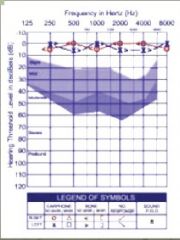
What kind of hearing loss is this?
|

Ha! Trick Question. No Hearing Loss. This is NORMAL hearing
|
|

What kind of hearing loss is this?
|
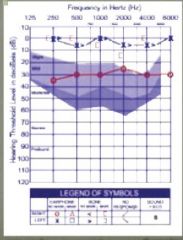
Mild conductive, left ear normal. Right ear loss of 26-40 dB. Conductive: sound can't reach inner ear.
BC thresholds are HIGHER than AC thresholds -> something is wrong with the MIDDLE or OUTER ear • ABG: RIGHT EAR ranging from 10 dB at 2000 Hz to 35 dB at 250 Hz |
|
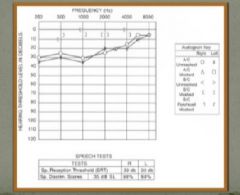
What kind of hearing loss is this?
|

Bilateral mild conductive loss.
BOTH EARS • CONDUCTIVE Hearing Loss – OUTER or MIDDLE ear is not working properly • BC is normal • AC suggest a decrease in hearing sensitivity • Typical – decreased sensitivity across all frequencies • Sometimes, hearing is better for HIGHER frequencies, like in this diagram. • ABG is present |
|
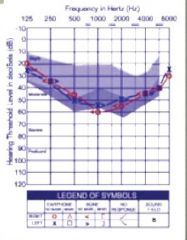
What kind of hearing loss is this?
|

SENSORINEURAL HEARING LOSS – BILATERAL MILD TO MODERATE
Mild to moderate HL can range between 15-70 dB • BC = AC results -> INDICATION of SENSORINEURAL Loss • If BC were separated or above AC by 15dB or greater, we’d have MIXED or CONDUCTIVE hearing loss • WHEN BC and AC are within 10 dB of each other, we have SENSORINEURAL Loss (if inner ear is poor, then both AC and BC are poor) |
|
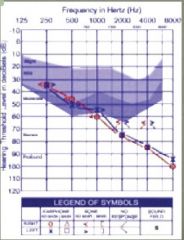
what kind of hearing loss is this?
|

BILATERAL SLOPING MILD TO PROFOUND SENSORINEURAL HL
• Mostly seen in older adults • Due to the severity of the HL in the HF, this patient might not be able to hear some speech sounds at all. |
|
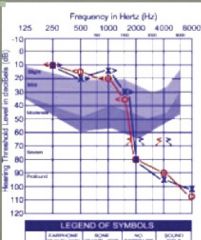
WHAT TYPE OF HEARING LOSS IS THIS?
|

BILATERAL MILD PRECIPITOUSLY SLOPING PROFOUND HEARING LOSS
MILD PRECIPITOUSLY SLOPING to PROFOUND means that the hearing loss is MILD for the lower frequencies, BUT at HIGHER frequencies, it gets worse. • Patients with this kind of hearing loss are fine in quiet rooms (LOW Frequencies are unimpaired), but understanding speech in a noisy environment is difficult • Many people with sensorineural loss experience a loss only at the HIGH frequencies • LOW FREQUENCIES: • 250Hz–750Hz • MIDDLE FREQUENCIES: • 1000 Hz – 3000 Hz • HIGH FREQUENCIES: • 4000 – 8000 Hz |
|
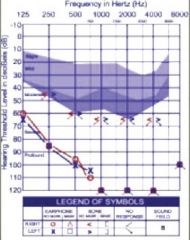
WHAT TYPE OF HEARING LOSS IS THIS?
|

BILATERAL PROFOUND SENSORINEURAL HEARING LOSS
Profound means Hearing loss is 90 dB or greater • AKA as ‘Left Corner’ audiogram |
|
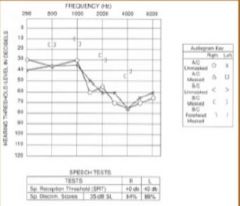
WHAT TYPE OF HEARING LOSS IS THIS?
|

BILATERAL MILD TO SEVERE MIXED HEARING LOSS
Conductive and Sensorineural loss in the SAME ear BC thresholds are lower than 20 dB HL at some or all frequencies = Sensorineural Loss Conductive hearing loss is demonstrated by the ABG |

